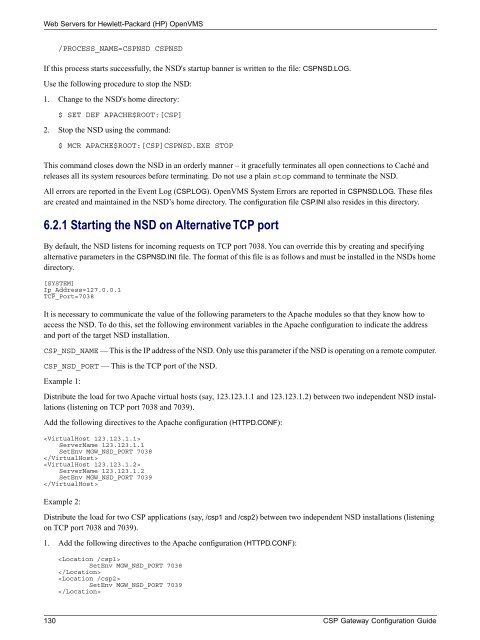CSP Gateway Configuration Guide - InterSystems Documentation
CSP Gateway Configuration Guide - InterSystems Documentation
CSP Gateway Configuration Guide - InterSystems Documentation
You also want an ePaper? Increase the reach of your titles
YUMPU automatically turns print PDFs into web optimized ePapers that Google loves.
Web Servers for Hewlett-Packard (HP) OpenVMS<br />
/PROCESS_NAME=<strong>CSP</strong>NSD <strong>CSP</strong>NSD<br />
If this process starts successfully, the NSD's startup banner is written to the file: <strong>CSP</strong>NSD.LOG.<br />
Use the following procedure to stop the NSD:<br />
1. Change to the NSD's home directory:<br />
$ SET DEF APACHE$ROOT:[<strong>CSP</strong>]<br />
2. Stop the NSD using the command:<br />
$ MCR APACHE$ROOT:[<strong>CSP</strong>]<strong>CSP</strong>NSD.EXE STOP<br />
This command closes down the NSD in an orderly manner – it gracefully terminates all open connections to Caché and<br />
releases all its system resources before terminating. Do not use a plain stop command to terminate the NSD.<br />
All errors are reported in the Event Log (<strong>CSP</strong>.LOG). OpenVMS System Errors are reported in <strong>CSP</strong>NSD.LOG. These files<br />
are created and maintained in the NSD’s home directory. The configuration file <strong>CSP</strong>.INI also resides in this directory.<br />
6.2.1 Starting the NSD on Alternative TCP port<br />
By default, the NSD listens for incoming requests on TCP port 7038. You can override this by creating and specifying<br />
alternative parameters in the <strong>CSP</strong>NSD.INI file. The format of this file is as follows and must be installed in the NSDs home<br />
directory.<br />
[SYSTEM]<br />
Ip_Address=127.0.0.1<br />
TCP_Port=7038<br />
It is necessary to communicate the value of the following parameters to the Apache modules so that they know how to<br />
access the NSD. To do this, set the following environment variables in the Apache configuration to indicate the address<br />
and port of the target NSD installation.<br />
<strong>CSP</strong>_NSD_NAME — This is the IP address of the NSD. Only use this parameter if the NSD is operating on a remote computer.<br />
<strong>CSP</strong>_NSD_PORT — This is the TCP port of the NSD.<br />
Example 1:<br />
Distribute the load for two Apache virtual hosts (say, 123.123.1.1 and 123.123.1.2) between two independent NSD installations<br />
(listening on TCP port 7038 and 7039).<br />
Add the following directives to the Apache configuration (HTTPD.CONF):<br />
<br />
ServerName 123.123.1.1<br />
SetEnv MGW_NSD_PORT 7038<br />
<br />
<br />
ServerName 123.123.1.2<br />
SetEnv MGW_NSD_PORT 7039<br />
<br />
Example 2:<br />
Distribute the load for two <strong>CSP</strong> applications (say, /csp1 and /csp2) between two independent NSD installations (listening<br />
on TCP port 7038 and 7039).<br />
1. Add the following directives to the Apache configuration (HTTPD.CONF):<br />
<br />
SetEnv MGW_NSD_PORT 7038<br />
<br />
<br />
SetEnv MGW_NSD_PORT 7039<br />
<br />
130 <strong>CSP</strong> <strong>Gateway</strong> <strong>Configuration</strong> <strong>Guide</strong>

















